The OnePlus 7 Pro Review: Outstanding Performance & Screen, Adequate Everything Else
by Andrei Frumusanu on June 19, 2019 12:00 PM EST- Posted in
- Mobile
- Smartphones
- OnePlus
- OnePlus 7 Pro
Display Measurement
The screen of the OnePlus 7 Pro is definitely the key feature of the phone. The 6.67” 3120 x 1440 resolution panel not only represents OnePlus’ highest resolution display to date, but the 90Hz display mode also makes it stand out above any other smartphone currently available.
Display Architecture: 90Hz - But How?
In our article covering the phone’s announcement, a big question for me was exactly how OnePlus had achieved the running of 1440p90 in terms of hardware implementation between the SoC and the panel DDIC. Initially I had theorised that OnePlus would have had to employ a dual-MIPI interface, doubling up on the hardware connections between the two chips.
To my surprise when investigating the device’s kernel source, this actually isn’t the case, and the OnePlus 7 Pro still only has a single MIPI interface to the DDIC. After a bit of research, the only explanation I have is that this must be one of the very first devices in the market which is implementing a newer D-PHY physical layer standard in the MIPI DSI interfaces. The SoC and DDIC must be using either a new D-PHY 1.2 or D-PHY 2.0 standard with much increased data transfer rates.
I was actually quite surprised by this and it’s generally excellent news for the phone as it means the hardware implementation was done in the most optimal way, as opposed to the less efficient dual-interface implementation on some other phones.
I did try to measure what the actual power drain of the screen was, but wasn’t able to get to quite as straightforward results as I wanted. Measuring input power into the phone, the device’s base drain was in line with last generation devices at ~550mW in 60Hz mode. Oddly enough turning on 90Hz had a large effect on the drain and increased base power by ~100mW.
Measuring the power on the device’s internal PMIC however showed good figures in line with the Galaxy S10 at a lower ~400mW, and no noticeable difference between the 60 and 90Hz modes. We’ll revisit this discussion later on in the battery results page, but for the moment I’m more inclined to believe the former (worse) numbers given the results I’ve achieved.
Display Measurement
The device’s screen gamuts are implemented in the traditional style with multiple pre-defined profiles. There’s a “Vivid” mode which goes beyond the DCI P3 standard, and there’s an accurate “Natural” mode that is also colour managed for Display P3 and sRGB content much like on the Galaxy S10.
On top of these, OnePlus also gives an “Advanced” option with sub-selections of the AMOLED, P3 and sRGB gamuts with a custom colour temperature slider. These later modes are quite a disappointment as we’ll see shortly.
As always, we thank X-Rite and SpecraCal, as our measurements are performed with an X-Rite i1Pro 2 spectrophotometer, with the exception of black levels which are measured with an i1Display Pro colorimeter. Data is collected and examined using SpectraCal's CalMAN software.
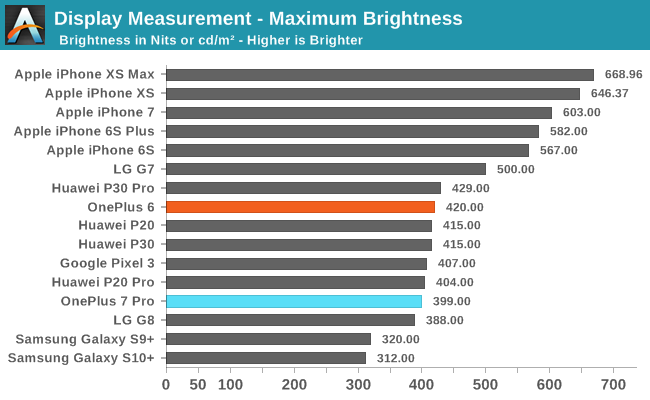
In terms of maximum brightness in manual mode, the OnePlus 7 Pro achieves up to 399 nits on full-screen white, which is in line with other phones which have dedicated high brightness modes in “Auto”. It’s to be noted that OnePlus here is quite a bit brighter than Samsung’s phones.
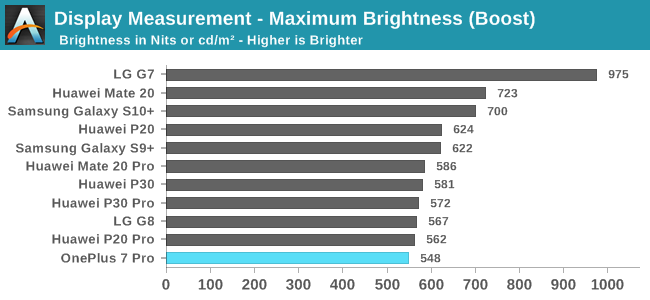
When high brightness mode is enabled under high ambient luminosity in the Auto mode, the OnePlus 7 Pro boosts up to ~548 nits. I was a bit surprised at this figure as it is well below OnePlus’ advertised figure of 800 nits at 100% APL. I again dug a bit deeper into the drivers of the panel and saw that the hardware isn’t allowed to go over 670nits in HBM. After further digging I discovered that the brightness behaviour in the Vivid mode is quite different and this actually even activates APL brightness scaling; here the phone is able to reach around the 670nits figure at 100% APL.
So although brightness of the phone’s display isn’t really an issue, it’s not quite as bright as advertised, and it also doesn’t quite reach the levels of some other phones by the competition when in accurate colour modes. Legibility in direct sunlight as captured above in the picture is still very good.
We’re measuring Grayscale accuracy in the device’s most accurate default mode; the “Natural” mode. At 200 nits brightness, the phone is showing good results. The biggest issue I see is that it’s veering off towards the warmer side with an average CCT of 6013 – the blues are clearly too weak in this display mode. The core issue here is that colour temperature over brightness isn’t quite linear and the brighter you get, the nearer to the target 6500K you get.
Gamma accuracy is also good, although just slightly above the target 2.2 mark at 2.36 average. The average is pulled up due to the first and last 10% of levels being too dark.
OnePlus had advertised an odd minimum of 0.27 nits in brightness which I had time to comprehend at the beginning. Indeed this mode is only available when enabling “Night Mode 2.0” on the phone, which is essentially the blue light filter mode. Without this, the phone’s minimum white brightness is a regular 1.88nits which is in line with what we see in the industry.
Again we’re seeing black clipping at the lowest intensity levels of the phone. Currently only Apple’s iPhone X and XS series are the only OLED devices on the market to able to handle this characteristic correctly.
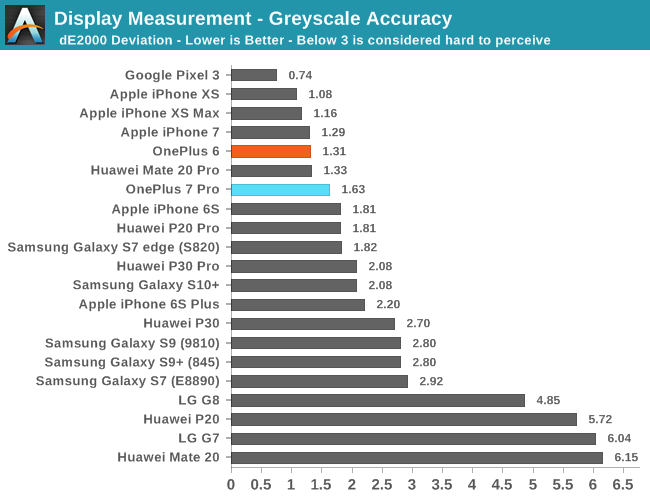
Overall the phone’s greyscale accuracy is good and in general most people won’t notice any issues in the “Natural” mode of the phone.
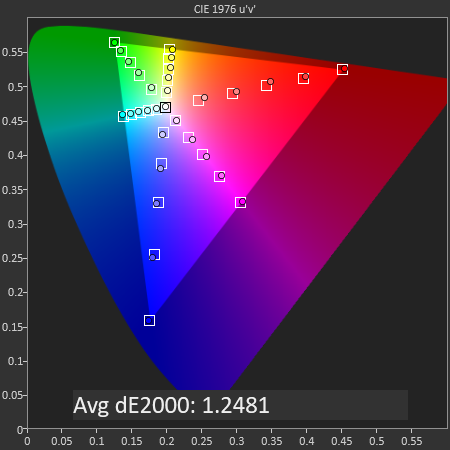
SpectraCal CalMAN
Natural Mode (sRGB)
In terms of saturation accuracy of the phone, we also measure the Natural mode as the most accurate profile, but I want to take a second to showcase an oddity of the phone’s Advanced mode in a second.
In the Natural mode, the phone was excellent saturation accuracy results with a deltaE2000 of 1.24, with only slight deviations in the lower red intensity levels.
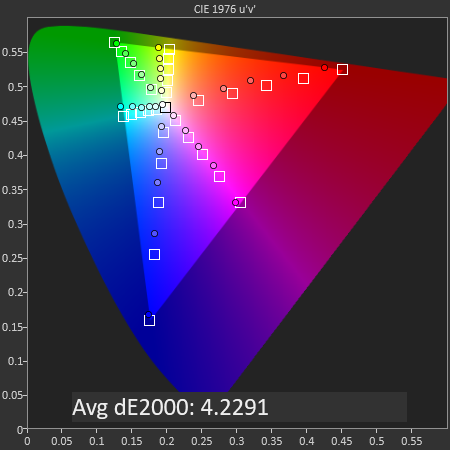
SpectraCal CalMAN
Advanced Mode sRGB
What’s really confusing is that the phone’s “Advanced” mode really isn’t that advanced. First of all the default colour temperature in this mode is very much off and too blue. For the above measurement I tried to get as close to accurate whites as I could with the slider (Slider around the 80% mark), however the results were still massively disappointing with results being quite over the place, resulting in a bad dE2000 of 4.22.
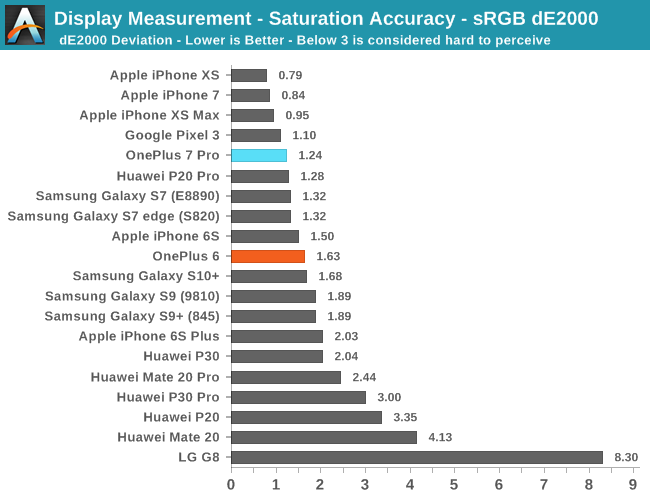
Nevertheless, I recommend the Natural mode and thus the display accuracy of the OnePlus 7 Pro in this regard ends up as extremely competitive and among the top performers.
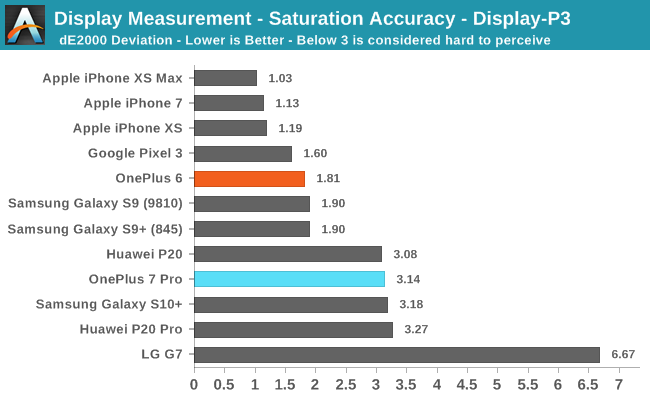
The Display P3 gamut is also available under the Advanced modes, although this mode also needed tuning to get to an acceptable colour temperature, and while the saturation accuracy was better than the sRGB mode, it still showcases some of the same deviations in the greens and reds and thus ends up with a dE2000 of 3.14 (yay for Pi).
In the Gretag-Macbeth chart of common colours such as skin-tones, the OnePlus 7 Pro ends up with excellent results with a dE2000 result of 1.63. There’s some devices that still beat it, but overall it’s still a fantastic result and should result in visually imperceptible differences to consumers.
Display Conclusion
Overall, the OnePlus 7 Pro’s display is excellent. While it doesn’t really break any records, OnePlus was able to currently deliver the best Android screen this year, besting even Samsung in terms of calibration.
While there’s always room for improvement, the only other issue I’d talk about is that the screen’s side curvature is quite of a larger radius than what we’ve seen from other more recent phones adopting this design. This does result in more reflections.



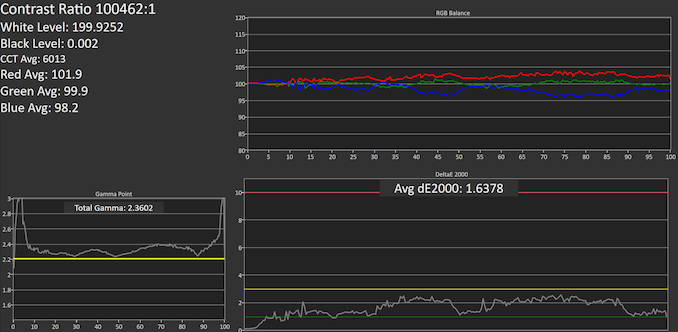


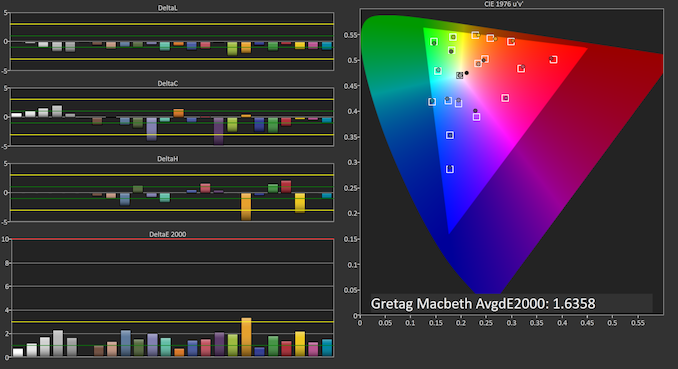
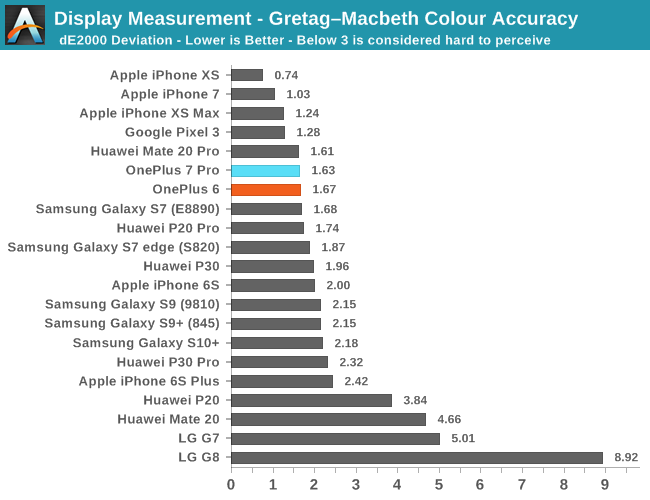









91 Comments
View All Comments
hadrons - Wednesday, June 19, 2019 - link
Currently great camera is a huge factor for premium phones and one plus has not been up to the big players for a long time, but still somehow people rate this phone better than a pixel phone. Every other Android manufacturers either lag behind or totally behind security or software updates and one plus is one among them. On a daily end user level scale, one plus is only as fast as the SOC and the Android version in it. Price is the only factor that I find some advantage in buying one plus.1_rick - Wednesday, June 19, 2019 - link
Not only that, but $670 for the base model (I'm only considering the Pro as you "can't get" the 7 in the US) is hardly a "flagship killer". That honor would more properly belong to something like the Xiaomi Mi Mix 3, at $470 on AliExpress.MrSpadge - Wednesday, June 19, 2019 - link
... or the Mi9, starting at 400€ in Germany (equivalent to ~400$ in the US).ilaicohen - Saturday, July 27, 2019 - link
Wth guys you can just download the Gcam and there you go, a better camera. And just saying, the camera isn't as bad as everyone says. Actually, it's pretty great. And about the price, it's half the price of the iPhone XS Max (with tax) so yea. It's a flagship killer. So cut off the bullshyt and go get yourself a OnePlus 7 Pro.badbanana - Tuesday, June 25, 2019 - link
i don't get this "..should have a better camera" thing. most users can't even tell what "f/2.0 lens" mean. for me, as long as it takes a clear photo, without the shakes then it's a "better" camera.i've owned every Samsung (for once never got any software updates) flagship since the S3 came out and found that OnePlus gets software updates whenever it's available.
systemBuilder - Friday, July 19, 2019 - link
I have a OnePlus 6T. The camera beats and iPhone 6S in dxomark. For me, that's "Good Enough". Freaking out over a compromise camera (cellphone cameras are ALWAYS compromise cameras) just shows that the reviewer has no perspective on life. I enjoy the on-screen fingerprint reader, the fantastic battery life, and the generous RAM & Flash Storage and the OLED screen, all at a great price.johansyren - Tuesday, November 10, 2020 - link
As someone who switched from a wireless charging phone to a OnePlus with insanely fast Dash charging, I genuinely prefer the later. I just don’t have to worry about charging my phone anymore. I’ve been on this phone for 1.5 years now and I’m still in awe every time I charge it because of it’s speed.
I read about it at https://casinovalley.ca/best-picks/best-gambling-p...
Most of the time I plug it in when I’m getting ready to head out and in 10 minutes it charges up to a point that I don’t need to worry about battery throughout the day. Wireless charging would be a nice bonus, but considering how slow it used to be comparatively, I’d still never actually use it.
Roy2002 - Wednesday, June 19, 2019 - link
It is a great phone, wish it has better cameras.XabanakFanatik - Wednesday, June 19, 2019 - link
No mention of the terrible stuttering when the phone is in 90Hz mode and you play a 60FPS video? OnePlus claims the display's refresh rate is adaptive to the content yet it cannot smoothly "adapt" to play a 60FPS video.By far the biggest complaint I have with the phone - If I want to watch a 60FPS video without terrible stutter, I have to go to the options and switch the display to 60Hz mode before, then switch it back to 90Hz mode after.
Xinn3r - Wednesday, June 19, 2019 - link
Now that's a deal breaker